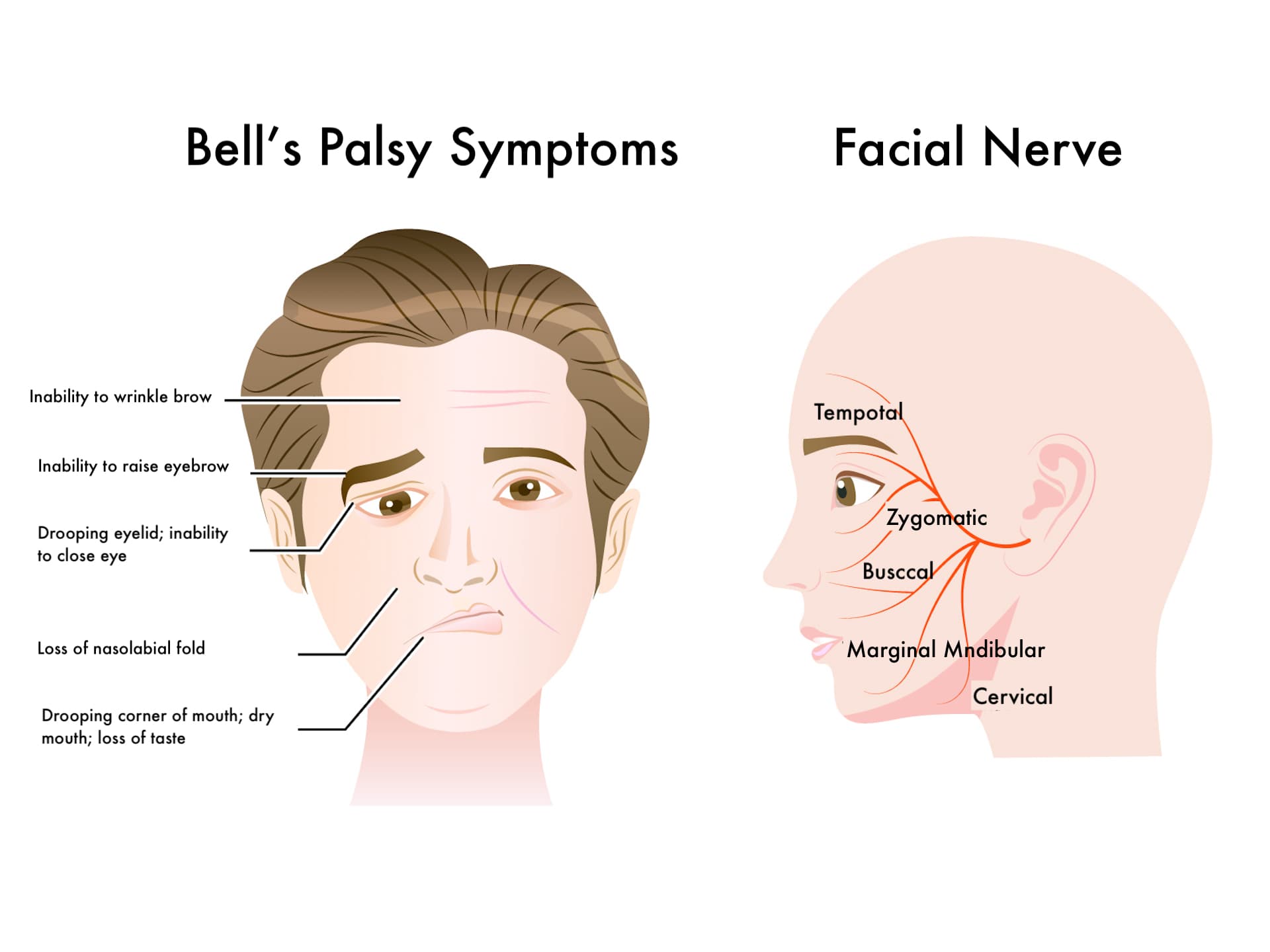How to Deal with Tinnitus (Ringing in Ears) 5 TIPS
I would like to share with you what you can do with 5 TIPS and how to manage one of the most annoying conditions: tinnitus or ringing...

August 10, 2024
Having Bell’s palsy can be a very overwhelming experience for so many people. What should I do? What does Bell’s palsy mean, etc.? Ultimately, you want to work with a qualified professional to diagnose the recovery. However, you can still learn about your mysterious condition by understanding the basics.
With that being said, let’s dive into the TOP 10 questions I often get asked from my patients about Bell’s Palsy.
We understand this can be a lot of information and overwhelming: if you are looking for more support and answers, set up a free consultation with our Bell’s Palsy Specialist, Satoru Ozawa. Share your story, get your questions answered, and learn how you can set yourself up for tremendous success in achieving a healthy life.

Bell’s palsy is a condition in which the facial nerve gets inflamed and swollen that, causes weakness and pain in one side of your face.
The facial nerve is a cranial number #7, responsible for facial expression muscles like squinting, frowning, etc. It starts from the brain (Pons), comes out behind the ear, and branches out in 5 different ways: temporal, zygomatic, buccal, and marginal mandibular and cervical branches. Each branch controls the other part of your facial muscle; for example, the temporal branch controls your eyebrow to raise up and down, or the buccal branch moves your upper lip so you can smile, etc.
The nerve fiber is like electrical wires that send signals and information from the brain to the muscles. When these are inflamed or swollen and cut the sign off, your muscle won’t be able to move or feel. That is what happens to your face when you have Bell’s palsy.
When you get Bell’s palsy, the condition progresses rapidly; within 72 hours, you might get the peak of severity. The symptoms can vary from case to case. Still, the most common symptoms are a weakness on one side of the face, including drooping of the eyelid, drooping of one side of the mouth, drooling, an inability to close the eye completely, excessive tearing, and pain in the eye, facial pain, loss of taste, hypersensitivity to sound, etc.
There is no conclusive answer regarding what causes the facial nerve to become inflamed or swollen. While most may not know, pregnant women, people with diabetes, and virus infections such as herpes simplex are at higher risk for Bell’s palsy.
You most likely have Bell’s palsy when you feel a weird sensation, and one side of your face is drooping. But so is stroke. How do you know if you have Bell’s palsy or stroke? Stroke is happening in the brain. On the other hand, Bell’s palsy is happening somewhere between your spine to face. Because of the human anatomical reason, the corner of the mouth droops when you have a stroke. However, your eyebrows have no problem, so you can still squint and frown when you have a stroke.
On the other hand, because the facial nerve is inflamed in Bell’s palsy, you will get drooping the mouth. You won’t be able to squint and frown simultaneously. That is the difference between a stroke and Bell’s palsy. However, self-diagnosis is very dangerous, so you should see your doctor when drooping. A CT scan is the best tool to rule out if you have a stroke or Bell’s Palsy.
Bell’s Palsy is usually just a temporary issue. Still, it might take longer for some people to fully recover than others.
It’s estimated that about 50% of people fully recover in a short amount of time. Another 35% have a good recovery within a year or less. Unfortunately, for a small percentage of about 15%, there may be permanent effects from the condition.
In most cases, about 85% of people who experience Bell’s Palsy will recover their facial function back to a normal or almost normal level.
However, it’s important to note that a group of 15% may need stronger treatment options.
The disorder typically lasts 7 to 10 days, beginning with sudden facial weakness. Most patients start to recover after 3 weeks, and around 85% will fully recover within 6 months. However, between 4 and 6% of patients may suffer severe facial muscle deformity, which may not return to normal. Additionally, around 10 to 15% of patients may experience asymmetrical facial movements on the same or opposite side of the face, which can be bothersome.
Resource: Bell’s Palsy Natural Treatments and Cures by Johnathan Porter
If you have Bell’s Palsy, it’s best to avoid cold and windy places. From what I’ve seen, there might be a connection between spending time at a breezy beach or going to an outdoor game and getting Bell’s Palsy. Some people may feel strange sensations or discomfort in their face or ears after coming back from these trips, and the next day, they may end up with Bell’s Palsy.
To find out more, please take a look at my other blog post titled “3 Important Things You Shouldn’t Do for Bell’s Palsy“. This post outlines important steps to take to prevent the condition from worsening or causing additional complications.
YES, it does. Massage helps reduce inflammation and makes a face move smoothly. I recommend stroking your face along the lines in this picture to stimulate facial nerves 2-3 times daily. You can stoke 5-10 times with your finger on each line.
The treatments focused on reducing nerve inflammation and swelling and restoring facial movement. Acupuncture has been shown in numerous studies to be incredibly practical in reducing pain and inflammation due to its ability to stimulate the body to release its natural painkillers. Facial exercises are a great way to re-educate your muscle function to restore.
With proper treatments, ones should be able to start noticing improvements within a few weeks and make a significant to complete recovery within three months. You can also get prescribed natural Chinese herbs to reduce inflammation and swelling of the facial nerve.
Bell’s palsy can cause pain in the face or behind the ear, as well as headaches. Some people may experience soreness or bruising-like sensations on their face. The affected area can be very sensitive to touch and tender around the ear. Sometimes you may experience a sudden sharp pain in your ear.
Yes. Acupuncture is very effective for Bell’s Palsy. During the initial acupuncture session, we examined facial movement and muscle tightness in your face.
Within six weeks to 3 months, most of our patients looked back to normal. They were close to 90% recovered regarding facial mobility. Even then, recovery is not guaranteed.

We'll be happy to answer your questions.
As a general rule of thumb, the sooner one receives treatment, the better the prognosis.
Some patients come for Bell’s Palsy treatment months or even years after the initial onset, and these chronic cases are often more complex and take a much longer time to achieve results. Even then, recovery is not guaranteed.
Regarding the frequency of treatments, Acupuncture follows a simple rule. Acute and relatively new conditions are most effectively treated with more frequent visits, whereas chronic and old conditions can benefit from more widespread treatments. In other words, if you just had an onset of Bell’s palsy, you will probably be prescribed 2-3 treatments per week in order to get the most effective results, and chronic cases will generally come in only once a week.
If you or a loved one was diagnosed with a low back pain and want to learn more about Acupuncture and whether it’s appropriate for your case, send us a message through our contact page. Thank you for taking the time to read this blog post! I appreciate your interest and hope to see you again for future posts.
We understand this can be a lot of information and overwhelming: if you are looking for more support and answers, set up a free consultation with our Bell’s Palsy Specialist, Satoru Ozawa. Share your story, get your questions answered, and learn how you can set yourself up for tremendous success in achieving a healthy life.
The following blogs discuss natural remedies, acupuncture, Chinese medicine, Chinese herbs, and tips for maintaining good health.
I would like to share with you what you can do with 5 TIPS and how to manage one of the most annoying conditions: tinnitus or ringing...
A 45-year-old man came to my clinic looking for some relief from the ringing in ears because he discovered that acupuncture might be a great option to...
I want to show how to alleviate tinnitus, which sounds like whistling, buzzing, roaring, or clicking, especially at night, using 10 acupressure techniques.

Satoru Ozawa, L.Ac, ATC
hariQ acupuncture & herbs
Licensed acupuncturist, Certified Athletic Trainer and Chinese herbal specialist. With his 10 years of experience in Oriental Medicine, he will recommend the best natural Remedies, including Acupuncture, Chinese herbs, and health tips to relieve your suffering.
5 comments